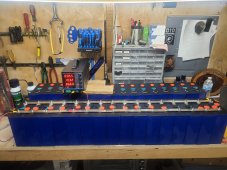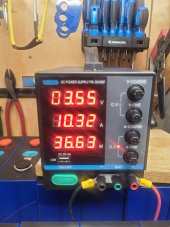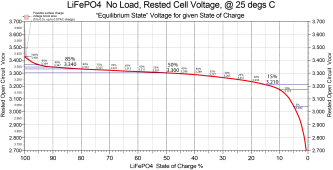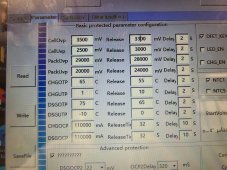You have until power supply goes into voltage limit at close to 3.65v on power supply readout before present lead wire voltage drop starts to impact charge time. You will see the power suppy current begin to drop off even though cells are only about 3.4v with the wire voltage drop you now have. With larger gauge wire with no more then 50 mV total pair wire lead terminal voltage drop it will have little impact on full charge time and the power supply current limit of 10 amps will be maintained almost all the way to 3.65v cell voltage.
This is the point where many folks make the mistake of jacking up the power supply voltage limit above 3.65v setting to raise the current back up to 10 amps. Never do this as when cells do get near full charge the current will drop off reducing wire voltage drop; and the power supply voltage limit will rise to the revised high limit you adjusted it to maintain 10 amp charge.
Remember the cell voltage will rise at a faster rate above about 3.4v cell voltage and the slow cell voltage rise rate accelerates faster then you have previously got acustom to up to that point. Don't assume you will manually catch the point when cells reach 3.65v and be able to tweak the power supply voltage limit back down. Murphy's law says this will happen in the middle of night when you are sleeping and you wake up to find cells sitting over 3.65v. This can be catastropic for cell bloating when folks are using the power supply vendor supplied cheap junk 16-18 gauge leads.
With the initial cell voltage starting at 3.295v (assuming your DVM is accurate), they are at about 50% state of charge and it is going to take the 9+ days per 16 cell parallel group (assuming these are 280 AH cells).
If you want to monitor the progress, assuming you have an accurate DVM, you can check voltage at cell terminals against attached graph.
This chart is for rested open circuit cell voltage. An LFP cell gets to about 95% recovery to its final equilibrium no load voltage in about 60 seconds after load or charge current is removed, this applies when cell is in the 20% to 90% state of charge range. Outside this SOC range it takes longer.
For the low charge rate you are using you should subtract off 10-20 mV from cell voltage measurement under the low charge rate to match this graph voltages. For higher charge rates the amount to subtract from cell reading increases. 0.05 CA charge rate subtract 25 mV, 0.1 CA subtract 35 mV, 0.2 CA charge rate subtract 50 mV for cells at about 25 degs C.
View attachment 66970







